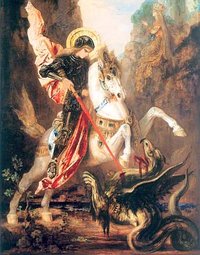Monster
|
|
- This article is about monsters as a kind of legendary creature, or an ishan. For other uses, see Monster (disambiguation).
Monster (lat. monstrum) is a term for any number of legendary creatures that frequently appear in mythology, legend, and horror fiction. The word originates from the medieval vulgar Latin verb monstrare, which translates either "to exhibit" or "to point out". Ancient peoples considered the birth of these freaks as representations of the wrath of the gods, a demonstration, as it were. The first so-named monstra were the showpieces in travelling carnival freakshows, people afflicted with body deformities or diseases like elephanitiasis.
They are also a mainstay of role-playing and video games. "Monster" usually, but not always, implies that these creatures are larger than human size. It almost always implies that the creatures are powerful and hostile to the hero, and must be overcome to succeed in the quest. The monster par excellence is the dragon.
Occasionally, there are monsters who act out of legitimate motives and their monstrous appearance leads to serious misunderstandings. One well known example is the Horta in the Star Trek episode, "The Devil in the Dark".
| Contents |
Monsters in history
Prior to its appropriation by the fantasy genre, the monster was an important social concept. Monsters were often associated with unknown lands and unknown things. For instance, historically, unexplored areas on maps would be marked indicating that monsters such as dragons lived there. This connection between monsters and the unknown meant that the monster was an important concept in the Renaissance and the Enlightenment, as Western society began to use science and other academic disciplines to try to understand the unknown. Monsters were seen as scientific puzzles — things science needed to understand. In the Enlightenment, the cabinet of curiosities would often include monsters in amongst the scientific instruments and toys. Similarly, the monstrous was an important concept on aesthetics during the enlightenment, often closely associated with the wondrous and the sublime.
This relationship between science and monstrosity became an important theme in many Victorian-era horror novels, where science was often depicted not merely as studying monsters, but as producing them. Notable examples include Dr. Jekyll and Mr. Hyde and Frankenstein. This change corresponded with a decline in the popularity of science among the general public.
Some traces of this classic relation to monsters can be found in the popularity of tabloid newspapers such as the Weekly World News. Contemporary philosophers such as Lorraine Daston have written at length about the relationship between how society depicts monsters and the role of science in that society.
Occasionally, monsters are depicted as friendly or misunderstood creatures. The monsters of Monsters Inc. scare to create the energy to run their secret world, and the furry monsters of Sesame Street live as complete equals to their fellow humans and animals.
Monsters in cinema
During the age of silent movies, there were representations of monsters of the size of a person, played by an actor in a costume: Frankenstein's monster, the Golem, and vampires are the most well-known ones. The film Siegfried showed a dragon that was a giant puppet on tracks. A few dinosaurs were presented by stop-motion animated models, something which was carried over into RKO's King Kong, the first giant monster of the sound era.
During the sound era, the film studio Universal specialized in monsters, offering Bela Lugosi's portrayal onscreen of his role in the stage play, Dracula, and Boris Karloff as Frankenstein's monster. They also made many lesser films, such as Lon Chaney, Jr.'s portrayal of an electrified zombie in Man-Made Monster. The entire notion of the werewolf was specified by the movies in this era, and a similar type of person afflicted with traits said to come from an animal was presented in The Cat People. Mummies also became a fearsome type of monster. And a variant of Dr. Frankenstein was played by Peter Lorre. His mad surgeon, Dr. Gogol, could transplant hands that brought with them a malevolent temperament that could still animate them in Mad Love, which became another genre. As for giant monsters, the serial Flash Gordon had a man in a monster suit who played a huge dragon by attacking a doll dressed like the title character. But the cycle played itself out, becoming comedic in Abbott & Costello meet Frankenstein of 1948.
After the Second World War, however, giant monsters returned to the screen in a pattern that has been causally linked to the invention of nuclear weapons. The first was American: The Beast from 20,000 Fathoms was a dinosaur that attacked a seaport. But later there were Japanese, British, and even a Scandinavian giant monster attacking cities. The tantalizing proximity of other planets brought the notion of alien monsters from outer space to the screen; some were huge, but cheaper movies had those of a more human scale. In this age as well, the monster type of the fish-man was developed in the series Creature from the Black Lagoon.
The British studio of Hammer brought color to the human-sized monster in the late 1950s. At this time, the earlier Universal films were shown on US television by independent stations (rather than being scheduled by a network) by mocking announcers, and these together gained a large number of young fans. Since that era, although the the type of monster has changed, it has not disappeared as it did in the late 1940s.
Religious monsters
Many Eastern religions such as Hinduism, as well as ancient religions such as Greek mythology and Norse mythology have an important focus on monsters, which are generally depicted as the enemies of the gods. Ragnarok in Norse mythology was the final battle between the gods of Asgard and the many monsters of the world.

